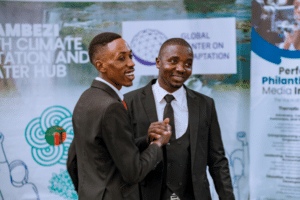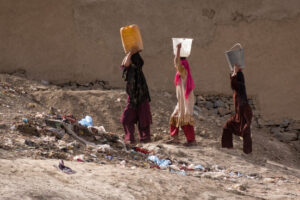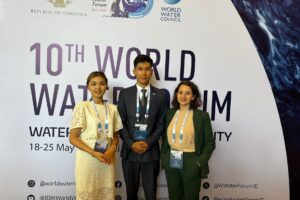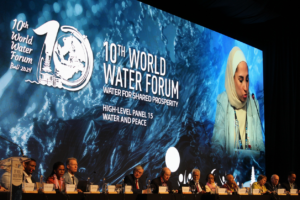Description
Dear participants,
We hope you all made the most of the action-packed Day 4 that had an intriguing networking session not to mention the six topics in the parallel sessions. The latter included insightful discussions in topics ranging from stakeholder engagement and youth perspectives in Central Asia and the MENA region to the youth perspective on global water quality; water and climate nexus in the context of COP 26 to low-tech sanitation solutions in the Americas.
And while you all are probably allowing the immersive learning of Day 4, or from the past four days, for that matter, to sink in, we have come to the last day of the 5th General Assembly. It’s been a week already! Time flies when you are having fun, doesn’t it?.
But worry not, we still have two interesting sessions in store for you on Day 5. We will then wrap up the Assembly with a closing ceremony, containing a quick recap of the week, in addition to several interesting presentations and inspirational talks. Only then we say our goodbyes. (Yes, we will miss you, too!)
PARALLEL SESSIONS RECAP
Day 4
HOW TO GET INVOLVED IN WYPW
Host: World Youth Parliament for Water (WYPW)
By Syed Nasar Alam
The second session of “How to get involved in WYPW” was hosted by Danielle Kamtié (ISW) and Alex Whitebrook (WYPW). Like the previous day’s session, Alex introduced the WYPW values, objectives, and descriptions of the purpose of each working group to the participants. The organization’s purpose and identity were described in the context of the severe water crisis in which water and the environment are interlinked. Water is the primary medium through which we will feel the effects of climate change either in the form of scarcity or water-related disasters.
Chapters and working groups are key elements of WYPW’s structure. Alex pointed out that “the chapters are very much independent in many ways” with the freedom to work on issues they think are most important in their region. Although there are currently approximately 30 WYPW chapters around the world, Mr. Whitebrook offered that there was always room for more chapters to be added. “Keeping volunteers motivated is the key” for launching a successful chapter Mr. Whitebrook explained. WYPW ensures that chapters are kept engaged and bylaw has been developed to guide chapter activities. Aside from chapters, working groups are the main way to translate WYPW’s objectives into practical work. One such working group is the Events Working Group which is essential to WYPW’s functioning. Mr. Whitebrookalso stressed that WYPW is always seeking to expand its working groups and encourages persons with new ideas to connect with the organization.
Mr. Whitebrook emphasized that the platform was mutually beneficial for members and WYPW as members “are the ones we rely on the most”. One important benefit of the WYPW membership is the opportunity for youth to connect with global water organizations. A mentorship program utilizing the WYPW platform was another avenue for capacity building that was suggested and lauded during the breakout sessions where enthusiastic participants voiced their eagerness to become a part of WYPW. Mr. Whitebrook indicated that there was support for a mentorship program as it would serve as a value-added service to members that could be enacted soon.
YOUTH PERSPECTIVES FROM THE MENA REGION
Host: By Mediterranean Youth for Water Network (MedYWat)
By Malaz Suliman
This session focused on the contribution of youth in the water sector in the Middle East and North African (MENA) region. Speakers described the state of the water sector and highlighted key challenges as well put forward recommendations and current initiatives.
Giuseppe Scandone of Mediterranean Youth for Water Network (MedYWat) was the first speaker and addressed the objectives of the MedYWat. MedYWat was launched in 2017 and it is a horizontal network in which everyone has power and everyone is a decision-maker. It gathers over 200 researchers, entrepreneurs, and activists. Giuseppe stressed the importance of collaboration with other organizations and described MedYWat as a piece of a puzzle that needs to be connected with other pieces in order to realize its full vision.
Lian Al-Dahshan of the independent Palestinian non-profit youth organization Save Youth Future Society detailed the water sector landscape in Palestine. One in four persons in the Gaza Strip receives water for up to 7 hours every day. Occupation-related restrictions, institutional weaknesses, and lack of funding were also identified as challenges in the water sector. Ms. Al-Dahshan also discussed an initiative in Palestine called ‘It will return back to you” which highlights the importance of the cleanliness of the sea.
The third speaker was Maya Atieh of the Lebanese Youth Parliament for Water. She presented on the water issues in Lebanon as well as the institutional and policy framework. According to Ms. Atieh, in Lebanon, only 35% of water demand comes from the public water sector. The inadequacy of wastewater treatment was also underscored. To address these issues, Ms. Atieh called for transparency and accountability in decision-making.
The last speaker was Redoine Khlifate of the Mediterranean Forum for SDG from Morocco. Mr. Khlifate spoke about his experience as a primary school teacher in a remote village earlier in his career where there was no electricity, water, or internet. He decided to be part of the solution and started to work with children. Now he gives workshops on the SDGs and works with about 15,000 children and young people.
YOUTH PERSPECTIVES ON BUILDING PUBLIC-PRIVATE PARTNERSHIPS
Hosts: World Youth Parliament for Water (WYPW), Red de Jovenes por el Agua Paraguay, World Economic Forum
By Ransford O.Tetteh
In this session presenters from WYPW, Red de Jovenes por el Agua Paraguay and the World Economic Forum illustrated the nature of public-private partnerships and explored mechanisms that youth employed to build trustworthy and collaborative relationships with the private sector.
Anna Huber, a water specialist at the World Economic Forum, introduced the session by distinguishing between the public and private sectors, emphasizing that public and private sectors “speak different languages”. Despite this, growth and development can be attained by fostering synergy between the two sectors through keeping an open mind, communicating effectively, aligning teams with each other, and building trust. However, Ms. Huber warned that private partners would not be interested in funding unrealistic and unclear projects due to the possible loss of investment
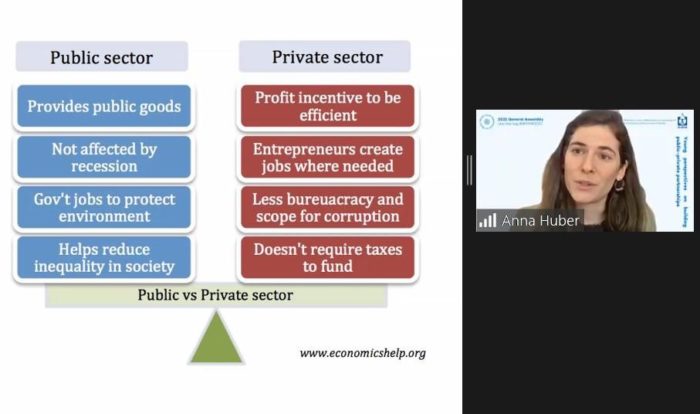
Differences between the public and private sector
Freeman Oluowo, coordinator at the Africa Centre for Climate Actions and Rural Development, impressed upon participants the impacts and challenges of water-related issues using the African continent as a case study. Society’s perspective of water as a renewable abundant resource, compounded by its essential role in competing for economic and social uses, has resulted in the slowing down of SDGs achievement, increased poverty, and disease burden, global health challenges, food insecurity, loss of biodiversity, and migration, among other things. Issues such as climate change, poor investment in water infrastructure, insufficient policies and regulation, and poor monitoring and governance hamper efforts to address water issues. Mr. Oluowo stressed that the cascading water and climate change challenges require youth to have a role in public-private partnerships. He beseeched the youth to invest in training, capacity building, research and innovation and local collaboration but to also make their actions transcend advocacy and engage in political leadership and governance roles.
Drawing on her experience with Red de Jovenes por el Agua Paraguay, Joyce Mendez gave a retrospective account of her journey involving youth activism and the fight towards water security by the Paraguayans. Beginning as a group of like-minded individuals hungry for change regarding climate change and water security, Ms. Mendez asserted that their perseverance and commitment resulted in the organization being recognized by the older generation and government. She reminded participants that, “We are not alone, we are only scattered but… We are already starting to get together”.

Key takeaway from Joyce Mendez’s Presentation
GLOBAL WATER QUALITY CHALLENGE
Hosts: World Water Quality Alliance (WWQA), Swiss Agency for Development and Cooperation (SDC), European Youth Parliament for Water (EYPW)
By Syed Nasar Alam
The session titled “Global Water Quality Challenge” was hosted by Hasmik Barseghyan (EYPW) with speakers including Andreas Steiner (Swiss Agency for Development and Cooperation, SDC), Ioana Dobrescu (Wetskills Foundation), Fiseha Bekele Teshome (Hawassa University), Susanne Hagen (Natuur & Milieu). The session covered global water quality challenges, youth engagement platforms, and ongoing projects related to water quality.
To open the session, Andreas Steiner explained the global water crisis and how SDC was tackling this issue and becoming a part of the global water campaign. Phenomenon such as population growth, urbanization, and climate change are pressuring water resources. In addition, Mr. Steiner indicated that “emerging pollutants such as microplastics or pharmaceutical residuals present a new global water quality challenge”, especially given that roughly 80 percent of wastewater goes directly into the environment without treatment. Antibiotic resistance is also a concern as “it kills and threatens the lives of millions of people and it’s actually among one of the world’s worst health issues that the world needs to address”. Moreover, there is not much known about the quality of water on a global scale. However, in developing countries, the majority of rivers are in good condition and there is still hope to protect these resources. SDC is engaging in water quality globally by promoting a water-safe world because the organization believes that no one is immune to water challenges and risks.
Irregular and inconsistent water quality assessments by water boards in the Netherlands have allowed for the deterioration of the quality of water resources in the country. Through citizen science, Ms. Hagen contended that citizens were utilized as a means to cover this gap in knowledge regarding water quality. Test results credibility was maintained by asking citizens to only use parameters they understood. Communication was key for the success of the whole project with people participating across the Netherlands and partners promoting the initiative.
The World Water Quality Alliance (WWQA) was introduced by Ms. Barseghyan as a global network of experts in the water sector. The organization “ensures that a well meaningful solution does not harm the interests of others, making the original problem worse”. WWQA is a social engagement platform that needs the youth to be part of its campaign and initiatives.
The session was ended with Mr. Teshome explaining how wetlands were being used to treat wastewater near lake Hawassa. The project addressed the gendered distribution of work associated with water collection as “women walk 10 km to fetch water from streams” that could still be contaminated.
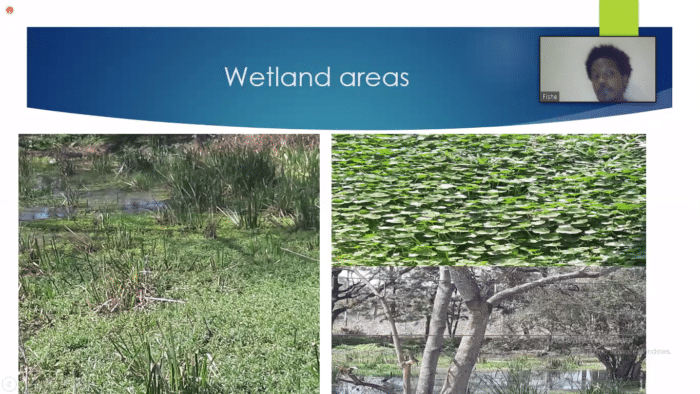
Hawassa Lake
